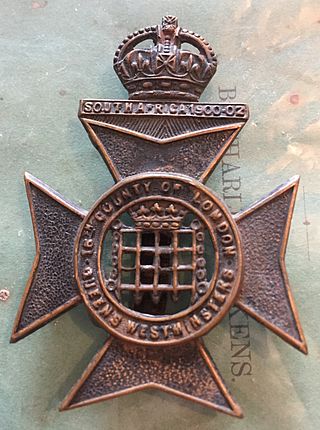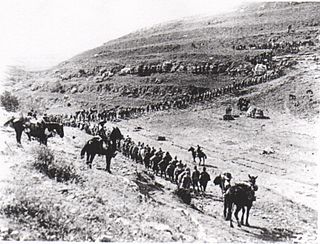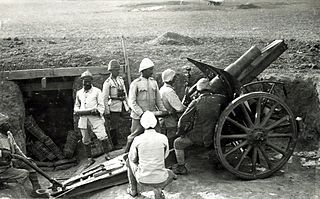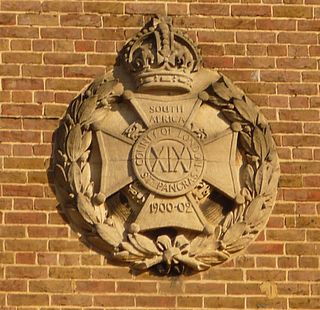Related Research Articles

The King's Royal Rifle Corps was an infantry rifle regiment of the British Army that was originally raised in British North America as the Royal American Regiment during the phase of the Seven Years' War in North America known in the United States as 'The French and Indian War.' Subsequently numbered the 60th Regiment of Foot, the regiment served for more than 200 years throughout the British Empire. In 1958, the regiment joined the Oxfordshire and Buckinghamshire Light Infantry and the Rifle Brigade in the Green Jackets Brigade and in 1966 the three regiments were formally amalgamated to become the Royal Green Jackets. The KRRC became the 2nd Battalion, Royal Green Jackets. On the disbandment of the 1st Battalion, Royal Green Jackets in 1992, the RGJ's KRRC battalion was redesignated as the 1st Battalion, Royal Green Jackets, eventually becoming 2nd Battalion, The Rifles in 2007.

The 60th Division was an infantry division of the British Army raised during the First World War. It was the second line-formation of the 47th Division, and was the second of two such Territorial Force divisions formed from the surplus of London recruits in 1914.

The 47th Division was an infantry division of the British Army, raised in 1908 as part of the Territorial Force.

The 33rd Division was an infantry division of the British Army that was raised in 1914, during the First World War. The division was raised from volunteers for Lord Kitchener's New Armies, that was originally made up of infantry battalions raised by public subscription or private patronage. The division was taken over by the War Office in September 1915. It served in France and Belgium in the trenches of the Western Front for the duration of the war. The division's insignia was the "double-three" from a set of dominoes.

The Queen's Westminsters were an infantry regiment of the Territorial Army, part of the British Army. Originally formed from Rifle Volunteer Corps, which were established after a French invasion scare of 1859. The unit became part of the newly established London Regiment on the formation of the Territorial Force in 1908. It was subsequently amalgamated in 1921 with the Civil Service Rifles, and became a territorial Battalion of the King's Royal Rifle Corps in 1937. It ceased to exist as separate entity after it was amalgamated in 1961.

The London Irish Rifles (LIR) was a reserve infantry regiment and then company of the British Army. The unit's final incarnation was as D Company, the London Regiment. On 1 April 2022 soldiers in the company transferred to foot guards regiments and the company became No 15 (Loos) Company, Irish Guards.

The First Transjordan attack on Amman and to their enemy as the First Battle of the Jordan took place between 21 March and 2 April 1918, as a consequence of the successful Battle of Tell 'Asur which occurred after the Capture of Jericho in February and the Occupation of the Jordan Valley began, during the Sinai and Palestine Campaign of World War I. During the First Transjordan attack large incursions into Ottoman territory occurred. Firstly the Passage of the Jordan River, was successfully captured between 21 and 23 March, followed by the first occupation of Es Salt in the hills of Moab between 24 and 25 March. The First Battle of Amman took place between 27 and 31 March when the Anzac Mounted Division and the Imperial Camel Corps Brigade were reinforced by two battalions of 181st Brigade followed by a second two battalions from the 180th Brigade and artillery. The Fourth Army headquarters located in Amman was strongly garrisoned and during the battle received reinforcements on the Hejaz railway, the strength of which eventually forced the attacking force to retire back to the Jordan Valley between 31 March and 2 April. The Jordan Valley would continue to be occupied by the Egyptian Expeditionary Force (EEF) through the summer until the middle of September 1918 when the Battle of Megiddo began.

The 58th Division was an infantry division created in 1915 as part of the massive expansion of the British Army during the First World War. It was a 2nd Line Territorial Force formation raised as a duplicate of the 56th Division. After training in Britain, the division joined the British Expeditionary Force (BEF) on the Western Front in 1917. It saw action at the battles of Arras and Passchedaele in 1917 and the German spring offensive in 1918. It then took part in the Battle of Amiens and the final Allied Hundred Days Offensive of the war. The division was recreated during the Second World War, as an imaginary deception formation.
The 179th Brigade was a formation of the British Army during the First World War. It was assigned to the 60th Division and served in the Middle East. Raised by Colonel, later Brigadier-General, Ned Baird.
The 181st Brigade was a formation of the British Army during the First World War. It was assigned to the 60th Division and served in the Middle East.

The 140th Brigade was an infantry brigade formation of the British Army's Territorial Army (TA) that had its origins in a South London Brigade of the former Volunteer Force. It served on the Western Front in the First World War and was recreated during the Second World War where it served only in the United Kingdom as a training formation.

The 141st Brigade was an infantry brigade of the Territorial Army, part of the British Army, that served in the First World War and remained in the United Kingdom throughout the Second World War.
The 169th Brigade was an infantry brigade of the British Army that saw active service in both the First and the Second World Wars. Throughout its existence the brigade, serving under numerous many different titles and designations, was an integral part of the 56th (London) Infantry Division. It served on the Western Front in the First World War, and in the North African and Italian campaigns during the Second World War.

The First Battle of Amman was fought from 27 to 31 March 1918 during the First Transjordan attack on Amman of the Sinai and Palestine Campaign of the First World War. The 60th (London) Division and the Anzac Mounted Division attacked the Ottoman garrison at Amman deep in enemy occupied territory, 48 kilometres (30 mi) from their front line, after capturing Es Salt and Shunet Nimrin. The Egyptian Expeditionary Force (EEF) was successfully counterattacked by Ottoman Empire forces forcing them to retreat back to the bridgeheads captured on the Jordan River.

The Battle of Hareira and Sheria was fought on 6–7 November 1917 when the Egyptian Expeditionary Force attacked and captured the Yildirim Army Group's defensive systems protecting Hareira and Sheria in the centre of the Gaza to Beersheba line, during the Southern Palestine Offensive of the Sinai and Palestine Campaign in World War I.

The 17th Battalion, The London Regiment , was a unit of Britain's Territorial Force formed in 1908 from Volunteer corps dating back to 1859. It saw considerable service on the Western Front, at Salonika and in Palestine during the First World War. It served as a motorised infantry regiment during the Second World War before conversion to an artillery unit in 1947 and subsequent amalgamation in 1967.

The 19th Battalion, London Regiment was a Volunteer unit of the British Army in existence from 1860 to 1961 under various titles. A detachment served in the Second Boer War and two full battalions fought in World War I, receiving the surrender of Jerusalem and crossing the Jordan among other exploits. During World War II the regiment operated as a searchlight unit and briefly as an infantry battalion, before becoming an anti-aircraft regiment in the postwar years.
The 20th Battalion, The London Regiment , was a unit of Britain's Territorial Force formed in 1908 from Volunteer corps dating back to 1859. It saw considerable service on the Western Front, at Salonika and in Palestine during the First World War. It served as a searchlight regiment and later as an infantry regiment during the Second World War.
The 151st Sikh Infantry – also designated 151st Punjabi Rifles, see nomenclature (below) – was an infantry regiment of the British Indian Army. It was formed in Mesopotamia and Palestine in May 1918, saw active service in the First World War and the Third Anglo-Afghan War, and was disbanded in May 1921.
The Structure of the Egyptian Expeditionary Force over the course of the First World War is shown below.
References
- ↑ "60th (2/2nd London) Division". The Long Long Trail. Retrieved 16 January 2012.